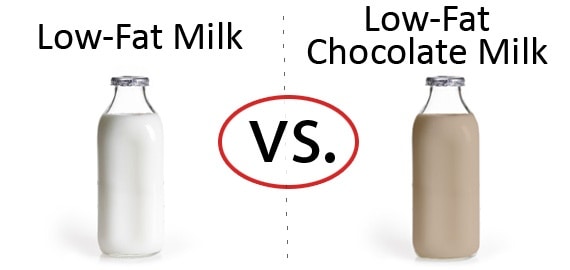
Written By: Gloria Tsang, RD
Title: Founding Registered Dietitian
Alumni: University of British Columbia
Last Updated on:


Despite many non-dairy milk on the market being nutritionally-fortified, cow’s milk remains a significant source of calcium, Vitamins A and D for many. Here we take a look at low-fat (1%) milk, both the plain and chocolate versions.
For ease of comparison, we’ve selected to compare 1% chocolate milk with 1% cow’s milk from the same brand.
Table of Contents
| Plain Milk, 1% Low-Fat (Great Value) | Chocolate Milk, 1% Low-Fat (Great Value) | |
| Serving Size: | 1 cup (240 mL) | 1 cup (240 mL) |
| Calories: | 110 kcal | 150 kcal |
| Fat: | 2.5 g | 2.5 g |
| Saturated Fat: | 1.5 g | 1.5 g |
| Cholesterol: | 10 mg | 10 mg |
| Protein: | 8 g | 8 g |
| Total Carbohydrate: | 13 g | 24 g |
| Sugar: | 12 g | 22 g |
| Sodium: | 130 mg | 220 mg |
| Vitamin A: | 15% DV | 15% DV |
| Vitamin D: | 10% DV | 10% DV |
| Calcium: | 25% DV | 25% DV |
| Ingredient List: | Lowfat Milk, Vitamin A Palmitate, Vitamin D3. | Lowfat Milk, Liquid Sugar (Sugar, Water), Less than 1% of Cocoa Processed with Alkali, Corn Starch, Salt, Carrageenan, Natural Flavor, Vitamin A Palmitate, Vitamin D3. |
Chocolate milk contains more added sugar, and therefore more total carbohydrates and calories. Cow’s milk naturally contains 12 grams of naturally-occurring carbohydrates (from lactose). As you can see from the nutrition facts table above, chocolate milk contains an extra of 10 grams added sugar, equivalent to 2.5 teaspoons of sugar.
Store-bought chocolate milk has more additives. While plain milk has Vitamins A and D added and nothing else, chocolate milk has a longer ingredient list. Typically, chocolate milk has an added sweetener (sugar or syrup), thickeners or emulsifiers (corn starch and/or carrageenan), and flavorings (cocoa, flavor, salt).
Chocolate milk is often added with salt. If you need to watch your sodium intake, perhaps make chocolate at home without added salt.
Obviously, without added sugar and additives, plain cow’s milk is preferable. Picking plain milk over chocolate milk avoids the added sugar and additives, such as artificial coloring or emulsifiers like carrageenan. However, milk as a beverage choice, whether plain or chocolate (2.5 teaspoons of added sugar), is still better than soda (10 tsp. of added sugar).
If you prefer plant-based, you may choose calcium-fortified plant-milk and focus on using other protein-rich plant-based foods to supplement protein. Flavored plant milk also contains added sugar, so don’t forget to check the nutrition facts table.
Alternately, if you’re concerned about the emulsifiers and other additives, chocolate milk can easily be made at home with cocoa powder and less sugar than the store-bought version. To make a hot chocolate drink at home, try adding one tablespoon of cocoa powder and one to two teaspoons of sugar to a glass of warm milk.
Alumni: University of British Columbia – Gloria Tsang is the author of 6 books and the founder of HealthCastle.com, the largest online nutrition network run by registered dietitians. Her work has appeared in major national publications, and she is a regularly featured nutrition expert for media outlets across the country. The Huffington Post named her one of its Top 20 Nutrition Experts on Twitter. Gloria’s articles have appeared on various media such as Reuters, NBC & ABC affiliates, The Chicago Sun-Times, Reader’s Digest Canada, iVillage and USA Today.
chocolate milk, grocery aisle, milk, nutrition faceoff